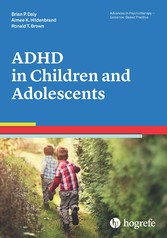
ADHD in Children and Adolescents

von: Brian P Daly, Aimee Hildenbrand, Ronald T Brown
Hogrefe Publishing, 2016
ISBN: 9781616764128
Sprache: Englisch
90 Seiten, Download: 2958 KB
Format: PDF, auch als Online-Lesen
1 Description
1.1 Terminology
Attention-deficit/hyperactivity disorder (ADHD) is a neurodevelopmental disorder marked by persistent patterns of inattention and/or hyperactivity-impulsivity symptoms that emerge during childhood and are functionally impairing across settings. The Diagnostic and Statistical Manual of Mental Disorders, Fifth Edition (DSM-5; American Psychiatric Association, 2013) assigns the following codes for this disorder:
314.01 Attention-Deficit/Hyperactivity Disorder, Combined Presentation
314.00 Attention-Deficit/Hyperactivity Disorder, Predominantly Inattentive Presentation
314.01 Attention-Deficit/Hyperactivity Disorder, Predominantly Hyperactive/ Impulsive Presentation
314.01 Other Specified Attention-Deficit/Hyperactivity Disorder
314.01 Unspecified Attention-Deficit/Hyperactivity Disorder
The International Classification of Diseases, 10th Edition, Clinical Modification (ICD-10-CM; World Health Organization [WHO], 2014) lists ADHD under codes F90.9 “Attention-Deficit Hyperactivity” and F90.0 “Attention-Deficit without Hyperactivity.” First described in the medical literature in the late 1700s (Barkley & Peters, 2012), ADHD-related symptoms were previously referred to by numerous labels including “minimal brain damage,” “minimal brain dysfunction,” “hyperkinetic impulse disorder,” “hyperactive child syndrome,” “hyperkinetic reaction of childhood,” and “attention deficit disorder,” among others (Taylor, 2011). Changes in terminology have generally reflected evolving theoretical conceptions based on symptoms of the disorder and its management.
1.2 Definition
According to the DSM-5, ADHD is “a persistent pattern of inattention and/ or hyperactivity-impulsivity that interferes with functioning or development” (American Psychiatric Association, 2013, p. 61), as defined by the following diagnostic criteria listed in Table 1.
Table 1 DSM-5 Diagnostic Criteria for ADHD
A. [Either] (1) and/or (2):
1. Inattention: Six (or more) of the following symptoms have persisted for at least 6 months to a degree that is inconsistent with developmental level and that negatively impacts directly on social and academic/occupational activities. Note: The symptoms are not solely a manifestation of oppositional behavior, defiance, hostility, or failure to understand tasks or instructions. For older adolescents and adults (age 17 and older), at least five symptoms are required.
a. Often fails to give close attention to details or makes careless mistakes in schoolwork, at work, or during other activities (e.g., overlooks or misses details, work is inaccurate).
b. Often has difficulty sustaining attention in tasks or play activities (e.g., has difficulty remaining focused during lectures, conversations, or lengthy reading).
c. Often does not seem to listen when spoken to directly (e.g., mind seems elsewhere, even in the absence of any obvious distraction).
d. Often does not follow through on instructions and fails to finish schoolwork, chores, or duties in the workplace (e.g., starts tasks but quickly loses focus and is easily sidetracked).
e. Often has difficulty organizing tasks and activities (e.g., difficulty managing sequential tasks; difficulty keeping materials and belongings in order; messy, disorganized work; has poor time management; fails to meet deadlines). f. Often avoids, dislikes, or is reluctant to engage in tasks that require sustained mental effort (e.g., schoolwork or homework; for older adolescents and adults, preparing reports, completing forms, reviewing lengthy papers).
g. Often loses things necessary for tasks or activities (e.g., school materials, pencils, books, tools, wallets, keys, paperwork, eyeglasses, mobile telephones).
h. Is often easily distracted by extraneous stimuli (for older adolescents and adults, may include unrelated thoughts).
i. Often forgetful in daily activities (e.g., doing chores, running errands; for older adolescents and adults, returning calls, paying bills, keeping appointments).
[A] 2. Hyperactivity and impulsivity: Six (or more) of the following symptoms have persisted for at least 6 months to a degree that is inconsistent with developmental level and that negatively impacts directly on social and academic/ occupational activities. Note: The symptoms are not solely a manifestation of oppositional behavior, defiance, hostility, or a failure to understand tasks or instructions. For older adolescents and adults (age 17 and older), at least five symptoms are required.
a. Often fidgets with or taps hands or feet or squirms in seat.
b. Often leaves seat in situations when remaining seated is expected (e.g., leaves his or her place in the classroom, in the office or other workplace, or in other situations that require remaining in place).
c. Often runs about or climbs in situations where it is inappropriate. (Note: In adolescents or adults, may be limited to feeling restless).
d. Often unable to play or engage in leisure activities quietly.
e. Is often “on the go,” acting as if “driven by a motor” (e.g., is unable to be or uncomfortable being still for extended time, as in restaurants, meetings; may be experienced by others as being restless or difficult to keep up with).
f. Often talks excessively.







